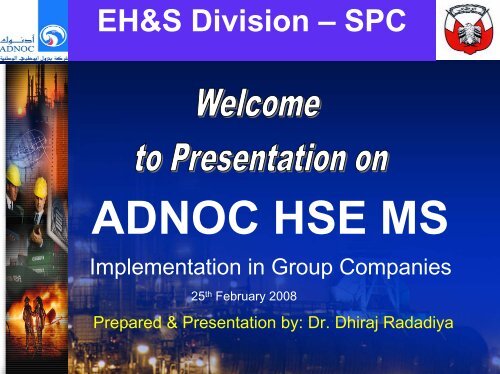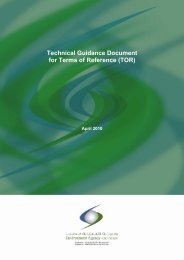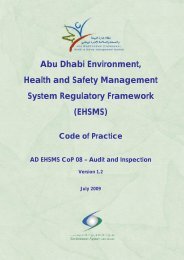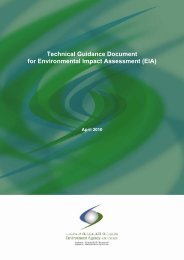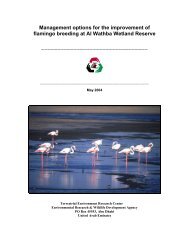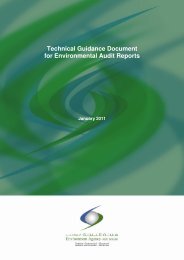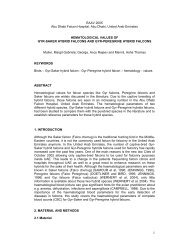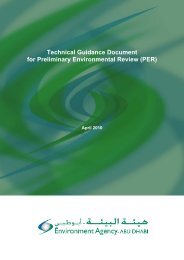ADNOC HSE MS
ADNOC HSE MS
ADNOC HSE MS
- No tags were found...
You also want an ePaper? Increase the reach of your titles
YUMPU automatically turns print PDFs into web optimized ePapers that Google loves.
EH&S Division – SPC<strong>ADNOC</strong> <strong>HSE</strong> <strong>MS</strong>Implementation in Group Companies25 th February 2008Prepared & Presentation by: Dr. Dhiraj Radadiya
Why <strong>HSE</strong> <strong>MS</strong> is required?• All top notchcompanies washaving <strong>HSE</strong> <strong>MS</strong>had majordisasters.
History of Disasters
Filxborough Disaster
Piper Alfa Incident
Fluxys Ghislenghien, Belgium 30 th July 2004Gasexplosion24 dead 150 injured– 500 M impact zone
KNPC Refinery Disaster
Texas Refinery Incident
Texas Refinery Incident
Buncefield Oil Storage Terminal Incident
Buncefield Oil Storage Terminal Incident
What went wrong?Lack ofLeadership &Commitment
Contents• Overview of <strong>ADNOC</strong>• <strong>ADNOC</strong> Commitment & <strong>HSE</strong> Policy• Framework for <strong>ADNOC</strong> Group Regulatory<strong>HSE</strong> documentation.• History of <strong>HSE</strong> <strong>MS</strong>• Current <strong>HSE</strong> <strong>MS</strong> Model• Monitoring Compliance framework• Challenges & Way Forward.
Overview of <strong>ADNOC</strong>
SPCEHS Division<strong>ADNOC</strong> Group activitiesExploration& ProductionServicesDrillingConstructionMarine ServicesPort OperationsChemical SupplyRefining& ProductsDistribution<strong>ADNOC</strong>Group ofCompaniesChemicals& Petro-ChemicalsFertiliserPolyethyleneChlorineNatural GasProcessingSales GasPropane/ButaneLNGExploration& ProductionOil & GasMaritimeProductTransportLNGCrudeRefinedProducts
Dimensions• ADCO• ADGAS• ADMA-OPCO• ADNATCO• <strong>ADNOC</strong>-Dist• Borouge• ESNAAD• FERTIL• GASCO (JV&ASR)• IRSHAD• NDC• NGSCO• TAKREER• ZADCOIndependent Operators that arenot part of <strong>ADNOC</strong> GC butoperate under <strong>ADNOC</strong> for <strong>HSE</strong>matters.• ADOC• TOTAL-ABK• BUNDUQ
<strong>ADNOC</strong> Commitment&<strong>HSE</strong> Policy
<strong>ADNOC</strong> and its Group Companies are committed to:• pursue the goal of no harm to people, which includes thecommunities/stake holders;• protect the environment;• develop and use energy resources efficiently to provideproducts and services;• manage <strong>HSE</strong> matters with the diligence accorded to its othercritical business activities;• play a leading role in promoting best practice in our industries;• promote a culture in which all Group employees strive for thecommitment;• be transparent in the public reporting of the Group’s <strong>HSE</strong>performance.In this way we aim to have an <strong>HSE</strong> performance for whichwe can be proud of, a good neighbour, contribute tosustainable development, earn the confidence ofcustomers & joint venture partners, and the society at large
<strong>ADNOC</strong> Aspiration<strong>ADNOC</strong> aspires to achieve an <strong>HSE</strong>performance that is exemplary inthe Middle East & African Regionand which is consistently equal to,or better than the performance ofits international joint venturepartners in their correspondingactivities.
<strong>ADNOC</strong> <strong>HSE</strong> Policy
Every <strong>ADNOC</strong> Group Company shall:• have a systematic approach to <strong>HSE</strong> management designedto ensure compliance with Abu Dhabi and U.A.E Laws andRegulations and adopted local and international standards;• conduct activities in a manner designed to minimise <strong>HSE</strong>risks to a level which is As Low As Reasonably Practicable(ALARP);• set targets for continuous <strong>HSE</strong> performance improvements;• measure, appraise and report performance;• hold appropriately empowered line management staffaccountable for <strong>HSE</strong> performance;• include <strong>HSE</strong> competencies and performance in theappraisal and reward of all staff;• empower all its employees to refrain from actions that areconsidered a threat to <strong>HSE</strong>;• require contractors to manage <strong>HSE</strong> in line with this policy.
How <strong>HSE</strong> Policy will beImplemented?<strong>ADNOC</strong> and its GroupCompanies will implement thispolicy through a documented<strong>HSE</strong><strong>MS</strong> and conduct periodicaudits to verify compliance.
Framework for <strong>ADNOC</strong> GroupRegulatory <strong>HSE</strong> documentation
Framework for <strong>ADNOC</strong> Groupregulatory <strong>HSE</strong> documentation• Statement of Commitment• AspirationCEO• <strong>HSE</strong> Policy& • Strategic <strong>HSE</strong> ObjectivesDirectorateStatementsUAE Law&RegulationsCodesofPractice<strong>HSE</strong><strong>MS</strong>Requirements&ExpectationsCorporate GuidelinesFramework DocumentsBestPracticeDocumentsShareholdersWorld industryOGPStructured as per<strong>ADNOC</strong> generic<strong>HSE</strong><strong>MS</strong>model• Essential features• Compulsory standards• Standard methods• Min/max limits• Monitoring requirementsFramework for achievingperformance leadershipRegulatoryFramework
Impact on Group CompaniesWhat is bestfor <strong>ADNOC</strong> GroupWhat is preferredby Group CompaniesUAE Laws&RegulationsStandardsInternationalPartnersStatement of CommitmentAspiration<strong>HSE</strong> PolicyStrategic <strong>HSE</strong> ObjectivesCodes of Practice<strong>HSE</strong><strong>MS</strong>GuidancetoOpcosStatement of CommitmentAspiration<strong>HSE</strong> PolicyStrategic <strong>HSE</strong> ObjectivesProcedures<strong>HSE</strong><strong>MS</strong>asdevelopebyindividuaGCInternationalStandardsExternalInfluences<strong>HSE</strong><strong>MS</strong> Requirements &ExpectationsPlans & TargetsGC’s <strong>HSE</strong><strong>MS</strong>Corporate <strong>HSE</strong> performance
<strong>ADNOC</strong> <strong>HSE</strong> <strong>MS</strong> History
<strong>ADNOC</strong> <strong>HSE</strong> <strong>MS</strong>In 1997, <strong>ADNOC</strong> launched its CorporateHealth, Safety and Environment ManagementSystem (<strong>HSE</strong><strong>MS</strong>).<strong>ADNOC</strong> believe that it is in its best interest tohave a common, comprehensive <strong>HSE</strong> Policywith closely aligned implementation andmanagement guidelines.Broad content was as follows;– 11 Elements - 63 expectations– Complex / multiple <strong>HSE</strong> Policies– Expectation overlaps - duplications– Omissions & gaps– Incompatible with external certification systems
<strong>ADNOC</strong> <strong>HSE</strong> <strong>MS</strong>As a matter of policy, <strong>ADNOC</strong> requires itsGroup Companies and contractors todevelop and implement their own <strong>HSE</strong><strong>MS</strong>,which should be compatible with thecorporate <strong>HSE</strong><strong>MS</strong>.Revision 2002Finalise gaps, shortcomings & overlaps,Simplify complex / multiple <strong>HSE</strong> Policies,Remove expectation overlaps & duplications,Fill-in omissions & gaps.
<strong>ADNOC</strong> <strong>HSE</strong> <strong>MS</strong>‣ The <strong>HSE</strong><strong>MS</strong> approach facilitates building and aligningsystematic processes for continual improvement inbusiness and <strong>HSE</strong> performance.‣ The <strong>HSE</strong><strong>MS</strong> is the umbrella under which all future<strong>ADNOC</strong> <strong>HSE</strong> initiatives will be developed andcoordinated.‣ Once fully implemented throughout the <strong>ADNOC</strong> Groupit will provide, amongst others:‣ clear <strong>HSE</strong> goals, targets, expectations, roles andresponsibilities,‣ reduced cost and improved efficiencies,‣ improved measurement and feedback mechanisms,‣ improved participation and mobilization of leadersand workforce, and‣ enhanced teamwork in <strong>HSE</strong> related activities.
<strong>ADNOC</strong> <strong>HSE</strong> <strong>MS</strong>Developed new <strong>ADNOC</strong> <strong>HSE</strong><strong>MS</strong>framework / model;Fix all previous problemsLong term suitabilityGeneric applicability (e.g. audit, benchmarking)Alignment with external certification systemsSuitable structure for Codes of Practices
Current <strong>HSE</strong> <strong>MS</strong> Model
<strong>HSE</strong> <strong>MS</strong> BasicsDeming's concept of PDCA Cycle:• PDCA:• Plan• Do• Check• ActPlanActDo DoCheck
<strong>ADNOC</strong> <strong>HSE</strong><strong>MS</strong> modelPolicy &Strategic Objectives9ContinuousImprovementOrganisation, Resources& Competence32Evaluation &Risk Management16Leadership &Commitment13Planning,Standards & Procedures21CorrectiveActionsImplementation &Monitoring15Audit10Management Review3xNumber of Expectations
Primary PurposeThe primary purpose of thisstandard is to provide amanagement tool to reduce therisk of occupational injuries,illnesses, fatalities, loss anddamages.
Basic purpose• To Integrate all requirements as business processunder one umbrella.• Main vehicle to implement all Regulatory, Internal /External Standards such as:– ISO 14001,– OHSAS 18001,– ISM Code of IMO,– API RP 75, ANSI Z10 and Codes of Practices etc.– PSM (Process Safety Management - OSHA 1910.119),• Management Based Safety Process,• Incorporate latest ISO 26000 on Corporate SocialResponsibility.• Provide Framework for Target setting, Feedbackand Continual Improvement.
Management Based Safety Process‣ Management clearly communicatingto employees what is expected;‣ Employees doing what is expected;and‣ Management assuring thatemployees do what is expected.
Risk based approachBalanced Score card Concept
<strong>ADNOC</strong> Semi-QuantitativeRisk Potential MatrixSEVERITYPeopleAssetsEnvironmentReputationAIMPROBABLE1 in 100,000yearsLikelihoodB C DREMOTE1 in 100,000yearsOCCASIONAL1 in 1000yearsPROBABLE1 in 100yearsEFREQUENT1 in 10years5. Catastrophic4. SevereMultiple fatalitiesor permanenttotal disabilitiesSingle fatalityor permanenttotal disabilityExtensivedamageMajordamageMassiveeffectMajoreffectInternationalimpactNationalimpactHIGH3. Critical2. MarginalMajor injuryor healtheffectsMinor injuryor healtheffectsLocaldamageMinordamageLocalisedeffectMinoreffectConsiderableimpactMinorimpactMEDIUM(ALARP)1. NegligibleSlight injuryor healtheffectsSlightdamageSlighteffectSlightimpactLOWHIGHMEDIUM -- Risk level is unacceptably high. This level of risk risk exposes the Company tointolerable losses to People, Assets, Environment or Reputation. The hazardshould be eliminated or its risk reduced to tolerable levels immediatelyRisk level is acceptable but must be managed at ALARP. Hazard must be managedto reduce frequency and/or severity of hazardous events to ALARP. Risk reductionmeasures must be planned and documentedLOW- Risk level is acceptable, no action required.
<strong>HSE</strong> <strong>MS</strong> Elements & Sub-Elements<strong>HSE</strong><strong>MS</strong> Elements(No. of Expectations)1. Leadership &Commitment (13)2. Policy & StrategicObjectives (9)3. Organisation, Resources& Competence (32)4. Risk Evaluation &Management (16)5. Planning, Standards& Procedures (21)6. Implementation &Monitoring (15)7. Audit (10)8. Management Review (3)1.1 Visibility (6)1.2 Proactive in target setting (3)1.3 Informed involvement (4)3.1 Roles & Responsibilities (6)3.2 Resources (3)3.3 <strong>HSE</strong> Advisors (6)3.4 Competence Assurance (4)3.5 Contractors (7)3.6 Communication (6)2.1 Policy (4)2.2 Strategic Objectives (2)2.3 Dissemination (3)5.1 <strong>HSE</strong> Plan (3)5.2 Asset Integrity (4)5.3 Standards, Procedures & Work instructions (5)5.4 Documentation - <strong>HSE</strong> Manual (3)5.5 Management of Change (3)5.6 Contingency Planning & Emergency Response (3)7.1 Audit Plan (4)7.2 Auditor Competency (4)7.3 Contractor auditing (2)Sub-elements (No. of Expectations)4.1 Identification (3)4.2 Evaluation & Assessment (4)4.3 Controls, Ownership & (3)Performance in maintaining controls4.4 Recovery (2)4.5 Recording and <strong>HSE</strong> Case (4)6.1 Implementation (4)6.2 Non-compliance & Corrective action (3)6.3 Performance Monitoring & Records (4)6.4 Incident reporting & Follow-up (4)
<strong>ADNOC</strong> <strong>HSE</strong> <strong>MS</strong>
Basic Requirements• Management and supervision (at alllevels) shall be regarded as being fullycommitted to <strong>HSE</strong> by all staff andcontractors.• They are to be seen as providing aleading role towards constantimprovement through leadership, theirbehaviours and action planning.• Their <strong>HSE</strong> performance will be assessedagainst achievement of annual objectives.
Basic Requirements• Companies shall have a written <strong>HSE</strong> policy,embodying, as a minimum, the <strong>ADNOC</strong> GroupPolicy contents.• <strong>HSE</strong> objectives shall be challenging, understoodby all and consistently incorporated in policies.• In setting objectives, management shall considerthe overall risk levels of their Companies’ activities,and shall identify those critical operations andinstallations requiring a fully documenteddemonstration that risks have been reduced to aslow as reasonably practicable (ALARP).
Basic Requirements• The necessary organisation and resources tocomply with the <strong>HSE</strong><strong>MS</strong> shall be provided.• Responsibilities at all levels shall be clearlydescribed, communicated and understood.• Staff shall be developed following structuredcompetency assessment and training systems.• Contractors will be required to manage <strong>HSE</strong> intheir activities as per or better than the companyobjectives.• <strong>HSE</strong> communication shall be effective andstructured to provide key information to all relevantorganisation levels.
Basic Requirements• The risk management process for all <strong>HSE</strong>-critical operations and installationsshall include:– an inventory of the major hazards to the environment and to the health and safety ofpersonnel, the public and customers from all the activities, materials, products andservices;– an assessment of the related risks, implementation of measures to control theserisks and to recover, in case of control failure.• The up-to-date inventory of hazards and assessed risks relating to the use,storage, transport and disposal of all products is available to the workforce,customers and others. Product stewardship shall be applied at all stages ofproduct life cycle relevant to the Company’s activities.• Health, Safety and Environmental impact assessment (including aconsideration of social impacts) shall be conducted prior to all new activities,facility developments and/or significant modifications to existing ones.• Health risk assessment shall address physical, chemical, biological,ergonomic and psychological health hazards associated with the workenvironment.• Soil and groundwater contamination shall be assessed and, where required,control or remediation shall be in-hand.• An <strong>HSE</strong> assessment shall form an integral part of any proposal for acquisition,divestment, abandonment or merger of business entities.
Basic Requirements• An <strong>HSE</strong> Plan shall be in place which demonstratespursuit of continual improvement principles at allorganisation levels.• <strong>HSE</strong> Critical equipment shall be subject to adequateasset integrity controls.• Adequate standards and procedures, derived from clearlydefined risk assessments/analyses, or internationallyacceptable practices shall be in place and understood atthe appropriate organisational levels. Preparation, reviewand distribution of all key reference documentation shallbe adequately controlled. Change, in all its typicalbusiness aspects, will be adequately controlled.• Emergency response procedures (including health,safety and environmental emergencies) shall be regularlytested.
Basic Requirements• All <strong>HSE</strong> critical activities shall be executed accordingto the set standards, procedures and workinstructions.• <strong>HSE</strong> performance targets shall be set to ensureprogression towards the long-term goals of no harm topeople and no damage to the environment.• Performance indicators shall be established,monitored and results reported in a way that can beexternally verified.• All <strong>HSE</strong> incidents and near misses with significantactual or potential consequences shall be thoroughlyinvestigated and reported and action shall be taken toavoid reoccurrence.
Basic Requirements• An audit programme shall be in placeto review and verify effectiveness ofthe management system.• It shall include audits by auditorsindependent of the process or facilityaudited.
Basic Requirements• Managementshall regularlyreview thesuitability andeffectiveness ofthe <strong>HSE</strong><strong>MS</strong>.
Compliance Monitoring framework
Compliance Monitoring Internal Audit of Group Companies;<strong>HSE</strong><strong>MS</strong> Self Assessment protocol. <strong>ADNOC</strong> Lead <strong>HSE</strong><strong>MS</strong> Audit – Every threeyears. This may vary with risk involved in GC. Group Company Annual <strong>HSE</strong> Letter External Audits:‣ Third party‣ Technical <strong>HSE</strong> Audit,‣ Insurance Audit,‣ Certification
<strong>HSE</strong> <strong>MS</strong> ImplementationProgress
Group Companies OverallImplementation Progress868483.584.75% <strong>HSE</strong> <strong>MS</strong> Implemented828078767477 77.1581.25722003 2004 2005 2006 2007YEAR
Individual Group Company Performance -200790% <strong>HSE</strong> <strong>MS</strong> ImplementedIRSHAD96949490888889858687858681756668ADCOADMAZADCOADOCTOTALBANDUQNDCADGASGASCO<strong>ADNOC</strong>-DISTTAKREERNGSCOADNATCOBOROUGEFERTILESNAAD1009080706050403020100
Challenges&Way Forward
ChallengesCorporate Social responsibilities‣ ISO 26000; <strong>ADNOC</strong> Responsibleglobal citizen.Climate Change;Time to actNature can not wait moreCompetency Assurance.
Way Forward‣ Launching <strong>HSE</strong> Awareness programmes;‣ More Familiarization with <strong>HSE</strong> <strong>MS</strong> for allMajor Contractors;‣ Training on <strong>ADNOC</strong> Code of Practices;‣ Focus on Competency Assurance System;‣ Establish database.
EH&S Division – SPCAny Questions?


